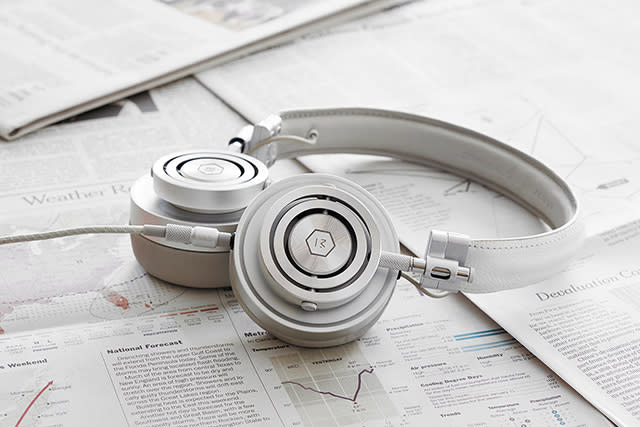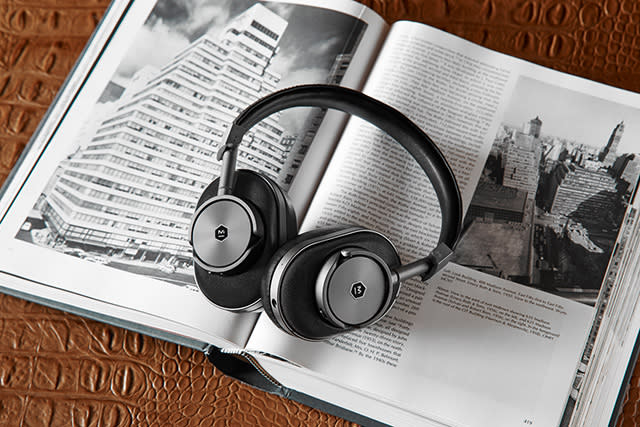The story behind Master & Dynamic's mix of sound and design
CEO Jonathan Levine on the importance of headphones that are built to last.

Master & Dynamic's latest headphones, the wireless over-ear MW60s, may have been announced ahead of CES, but that didn't stop me from getting the story behind the excellent aesthetics. I sat down with CEO Jonathan Levine to find out why design is so important to him and what the results are like when you aren't willing to compromise on materials and sound quality. By the end of our talk, I even got a hint of what we'll see from the company in 2016.
For folks who may not be familiar with Master & Dynamic, can you give a quick rundown of what you guys are all about?
We are a New York-city based design-driven premium audio company that's new to the market, but making great strides. We really focus on that combination of great design, luxury materials, amazing craftsmanship and, of course, we don't compromise when it comes to the sound. Everything is of equal importance, but we believe the combination of three — materials, comfort and performance — is really what's helping the brand differentiate itself in a somewhat crowded market.
The company boasts that its headphones are designed for decades of use, could you explain what that means?
One of the videos we created for the MH40 shows people the manufacturing process. We start with forged aluminum. People thought I was crazy to do and persevere, but I really wanted a certain weight and feel, and, of course, durability. In a world where everything is designed to be obsolete in a year and replaced, that's not how we want to approach it and interact with our consumer. We want something that lasts. They can replace the earpads as they might wear or the cables as they might fray. Those aren't issues that we have, but they're just common wear and tear on products. We want consumers to feel good about what they're using and get value out of it.
Of course, we love having them displayed on our stand. We're very proud of it. I'm always amazed when I got into an office of someone who has my headphones and they're always proudly displayed Sometimes they're on a shelf as an object of art and not actually being used. In that case, I encourage them to get a second pair.
Let's go back to the replaceable parts, which is not something that's commonly available from other companies. How does that enhance the overall experience?
We don't cheat on anything. When you look at our packaging, how everything is laid out and the round leather box for the cables, people really respond to that. Everything has a very tactile nature and it is really thought out. In my opinion, it has to be seamless. In today's world, whatever business you're in, you have to deliver the best experience and the best solution you can. That's very important to us, and I think it's definitely been resonating with our consumers who really appreciate what we're doing.

In addition to design, the combination of materials that Master & Dynamic uses definitely contributes to that experience.
There are other people using leather, but we use a particular memory foam for our earpads and that's why they're so comfortable. Particularly with the MH40 over-ear, I get asked all the time: are these noise canceling? They've used them and they're amazing, but they're actually passive noise isolating. We don't do anything with noise cancellation because we don't want to dampen the sound quality. When you fly with these things in particular, which is where noise cancellation comes into play, people always say that the headphones were so comfortable. Even after a six-hour flight across the Atlantic, they talk about how they watched several movies and never felt any pressure.
These headphones are a little bit heavier than your average headphones. That was really important because heft conveys quality and durability, yet we've been able to synthesize the blend of weight, heft and materials and not compromise comfort. You have to persevere. You can do it, but you have to want that excellence without compromising.
The Master & Dynamic headphones are more that just good design, they sound really good, too. Was sound quality something that, along with design, you weren't willing to compromise on from the beginning?
To produce a premium headphone and not have it sound great, that would be a miss. Usually when headphones are good looking, they don't sound great. And usually when something sounds really great, it's not good looking. Nothing you really want to wear outside your home or office. We're able to thread that needle.
We had to have the right sound quality. We're not in the sound production business, we're in the sound reproduction business. We want that music to sound the same as that artist intended it to be. We don't want to to tweak and change things. I think that's why people refer to our sound profile as genre neutral, which is exactly what we want it to be.

This year, your first wireless headphones were introduced. What are the challenges in going from a wired headphone to a wireless set?
The null hypothesis in the industry is that you can never create wirelessly what you can wired. There are still people who have an aversion to wireless. For us, just like we didn't want to do the noise cancellation because we didn't want to degrade the music quality, when we went to wireless, we didn't want to do anything to compromise our coveted sound profile.
The other thing is we didn't want to compromise our materials and design aesthetic. The product teams in the US and Asia worked together to come up with the best solution. We don't look at what other people are doing, which I think is important. We do what is right for us. I think that's why we're surprising people. As a new company, we come up with our own unique solutions.
For someone who is unfamiliar with Master & Dynamic, what product would you suggest they start with as an introduction to what you're all about?
That's tough. I'd have to go back to the MH40. It's not our least expensive product, but it's what people would call our flagship. It's iconic in terms of design and it's great in terms of comfort and sound quality, so that's where I would direct people.
Our in-ears are great for people who don't have a lot of money to spend. Those are pretty spectacular, and again, will last a really long time. That's most important. You don't have to replace these things every six months, but it's something you can use for years. But always get a stand. Make sure you get a stand.
Lastly, are there any big plans for 2016 that you're willing to share?
I think people think that wireless is the future, but for a product like ours, there's still a percentage of people that want wired because of the way we do it. We will definitely be introducing more wireless products — on-ears, in-ears, things like that — in 2016. And we'll see where we go from there.
This interview has been condensed and edited.
